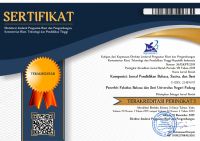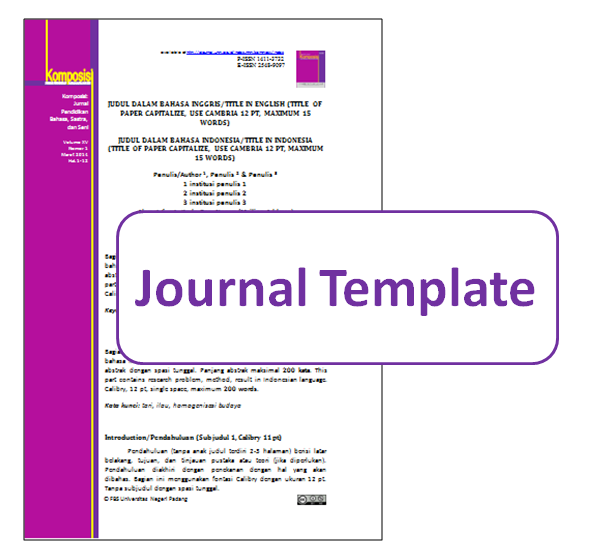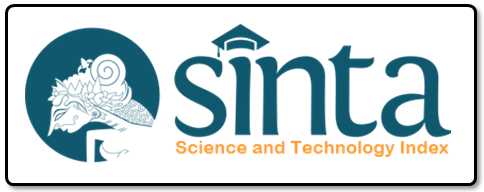IMPLEMENTING COLLABORATIVE LEARNING LSLC BASED INSTRUCTION TO ENHANCE TEACHERS` PROFESSIONAL DEVELOPMENT
Yenni Rozimela, Syamwil Syamwil, Nora Fudhla
Abstract
Even thought collaborative learning is not new in learning English, there are indications that there are still many teachers who do not understand the concept and cannot implement it properly. This article presents the results of the introduction / training of LSLC-based collaborative learning concepts in two Senior High School at Padang for two subjects. The training was conducted in two stages. The first stage was the introduction of concepts. The second stage was training by following the LSLC learning steps: Plan, Do, See. All teachers who participated in the training of the two schools took part in these stages. The results of the implementation indicate that the teacher understood the concepts of collaborative learning and lesson study and they can be considered skillfull enough in implementing collaborative learning.
Keywords
LSLC, collaborative learning, plan, do, see
References
Apriono, D. (2013). Pembelajaran kolaboratif: Suatu landasan untuk membangun kebersamaan dan keterampilan kerjasama. Diklus.Edisi XVII, No. 01, hal. 292-303
Asari, S. (2017). Sharing and jumping task in collaborative teaching and learning process. DIDAKTIKA: Jurnal Pemikiran Pendidikan, 23(2), 184-188.
Baker, M. J. (2015). Collaboration in Collaborative Learning. Interaction Studies: Social Behaviour and Communication in Biological and Artificial Systems, 16(3), 451-473. November 2015. Special issue on “Coordination, Collaboration and Cooperation: Interdisciplinary Perspectives”. Guest editors: Federica Amici, Lucas M. Bietti.
Burke, A. (2011). Group work: How to use groups effectively. Journal of Effective Teaching, 11(2), 87-95.
DIllenbourg, P. (1999). What do you mean by Collaborative Learning? In Dillenbourg P (Ed). Collaborative Learning: Cognitive and Computational Approaches.(1-19). Oxford: Elsevier
Farrell, T. S. (2015). Reflective language teaching: From research to practice. Bloomsbury Publishing.
Gokhale, A.A. (1995). Collaborative learning enhances critical thinking. Journal of Technology Education, 7(11), 22-30.
Lai, E. R. (2011). Collaboration: A literature review. Research Report. Pearson. http://www.pearsonassessments.com/
Margowati, D. (2009). Penerapan Model pembelajaran Kolaboratif Disertai Strategi Kuantum Learning dalam Meningkatkan Hasil Belajar Biologi. Skripsi. Universitas Sebelas Maret. https://eprints.uns.ac.id/5236
Poulos, J., Culberston, N., Piazza, P., & D'Entremont, C. (2014). Making space: The value of teacher collaboration. The Education Digest, 80(2), 28.
Rozimela, Y. (2018). Exploring the Challenges of Collaborative Planning in the Implementation of LSLC in Micro Teaching. Makalah disajikan pada ICLS 9 UNPAK, Bogor. Indonesia
Rozimela, Y., & Tiarina, Y. (2018). The Impact of Reflective Practice on EFL Prospective Teachers' Teaching Skill Improvement. JOURNAL OF LANGUAGE TEACHING AND LEARNING, 8(1), 18-38.
Suryani, N. (2008). Implementasi model pembelajaran kolaboratif untuk meningkatkan keterampilan sosial siswa. Program Pascasarjana UNS.
Widjajanti, D. B. (2011). Mengmbangkan Kecakapan Matematis Mahasiswa Calon Guru Matematika Melalui Strategi perkuliahn Kolaboratif Berbasis Masalah.Prosiding Seminar Penelitian, Pendidikan dan penerapan MIPA, Fakultas MIPA, UNY, hal (1-7)
Wildani, I. (2011). Penerapan Model Pembelajaran Kolaboratif MURDER untuk Meningkatkan Kemampun Penalaran dan Pemecahan Masalah: Studi pada mata pelajaran Matematika di MA Kab. Kampar Riau. Thesis.UPI: Repository.upi.edu/7549/
DOI:
https://doi.org/10.24036/komposisi.v20i1.102689
Refbacks
There are currently no refbacks.
Copyright (c) 2019 Komposisi: Jurnal Pendidikan Bahasa, Sastra, dan Seni
This work is licensed under a
Creative Commons Attribution-NonCommercial 4.0 International License .
Komposisi: Jurnal Pendidikan Bahasa, Sastra, dan Seni , a peer-reviewed online journal in languages, literature, and arts education.
Printed ISSN 1411-3732 , Online ISSN 2548-9097 .
Currently, Komposisi: Jurnal Pendidikan Bahasa, Sastra, dan Seni is indexed by: View My Stats
Visitors since February 2017:
Statcounter <div class="statcounter"><a title="web analytics" href="http://statcounter.com/" target="_blank"><img class="statcounter" src="//c.statcounter.com/11239717/0/d5796c6b/0/" alt="web analytics"></a></div> View My Stats
Published by:
Universitas Negeri Padang (UNP) Address: Faculty of Languages and Arts (FBS) Universitas Negeri Padang. Jl Prof. Dr. Hamka Air Tawar Barat, Padang - West Sumatera -Indonesia Telp/Fax. +62751 7053363 Home page: http://ejournal.unp.ac.id/index.php/komposisi | e-mail:komposisi.fbsunp @ fbs.unp.ac.id | cc: havid_a @ fbs.unp.ac.id
Server Luar
slot88
King Wood Car Care slot gacor
scam
situs toto
bandar togel
bandar togel
Slot Gacor Hari ini
situs toto
situs toto
toto togel
togel online
topup murah
harapan777
AMDBET
toto togel
slot88
login bayar4d
macau303
slot resmi apk slot online Slot Maxwin
situs toto
sakti55
situs toto felix168
nextogel
NEXTOGEL
NEXTOGEL
NEXTOGEL
NEXTOGEL
NEXTOGEL
NEXTOGEL
NEXTOGEL
NEXTOGEL
NEXTOGEL
NEXTOGEL
NEXTOGEL
NEXTOGEL
NEXTOGEL
NEXTOGEL
NEXTOGEL
NEXTOGEL
NEXTOGEL
NEXTOGEL
NEXTOGEL
NEXTOGEL
NEXTOGEL
NEXTOGEL
NEXTOGEL
NEXTOGEL
NEXTOGEL
NEXTOGEL
NEXTOGEL
NEXTOGEL
NEXTOGEL
NEXTOGEL
NEXTOGEL
JEPETOGEL
JEPETOGEL
JEPETOGEL
JEPETOGEL
KIM369
KIM369
KIM369
KIM369
KIM369
KIM369
KIM369
KIM369
KIM369
KIM369
situs toto toto slot kuntogel
situs toto toto slot sendok88
togel online toto slot https://www.eaglehighplantations.id/
toto macau
slot gacor slot gacor
batak5d toto slot Slot88 www.onscripture.com
slot online
situs toto
situs gacor bandar togel resmi toto togel https://montreallawfirm.com
wild west gold sering pecah
Toto 4D
slot88
toto macau
Situs Toto
Situs Toto
https://mercubuana.org/
Toto 4d
toto 4d
Toto 4D
toto 4d
info rtp akurat malam ini
Wanita Subang Beli mobil dari Nolimit city
rahasia Cuan Aztech Gems
Gatot kaca Buat TKW Jadi jutawan
Rahasia sukses bermain Mahjing wins
harapan princess starlight
Harapan sweet bonanza
taktik gates of olympus xmas
dukungan gates olympus
rahasia sukses bermain mahjong ways
Situs togel
slot gacor 2025
luxury89
Sulebet
sulebet
oja89
basic4d
situs toto togel online
vipbet888
momo128 login
https://garudafood.org/
jpmania mesin128
mesin128
mesin128
oja89
slot gacor
jumat4d slot login
https://pintu-pro.id/
slot gacor
Buat yang suka cari link slot gacor hoki69 maxwin tiap hari, ini tempat yang paling sering gue datengin.
choicehomecontractors.com
sarangslot
slot 4d gacor hari ini
Toto 4D
https://up2m.pkr.ac.id/jepangbet/
slot
simpatitogel
slot gacor hari ini
slot gacor
slot
https://unesa.id/












